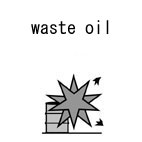| Case Name |
Explosion and fire of a distillation tank at a waste oil regeneration factory |
| Pictograph |

|
| Date |
July 29, 1983 |
| Place |
Osaka, Osaka, Japan |
| Location |
Waste oil recovery |
| Overview |
Distillation was stopped temporarily at a factory where waste oil was processed into reclaimed oil by distillation. On restarting, smoke came from the receiving tank, and gas leaked out from a heating tank used for distillation, and ignited. Metal drum cans storing waste oil stacked up around the site caught fire. The metal drums were heated, increasing internal pressure and they were scattered while bursting into flames. Most of wastes are outside the application of laws on safety, and the person dealing with wastes lacked awareness of safety. For flammable waste management, not only self-protection, but also administrative instructions are necessary. |
| Incident |
At a factory where various waste oils were processed into reclaimed oil by filtering and distilling, white smoke spouted out from a receiving tank and there was a smell of thinner during a distillation operation. White smoke also came out from the lower side of a heating tank used for distillation. An explosion occurred while an inspection was carried out and adjacent metal drum cans that stored waste oil illegally detonated sympathetically. The lid of the burning drum cans flew off. |
| Processing |
Manufacture |
| Individual Process |
Waste oil recovery |
| Process Flow |
Fig2.Unit process flow
|
| Substance |
Waste oil |
| Type of Accident |
Fire, explosion |
| Sequence |
19:00. on July 28th, 1983. Feedstock waste oil was distilled for two hours, and left for one night.
09:10. on July 29th. The distillation was restarted.
09:15. Smoke and a thinner odor were generated from the upper side of the receiving tank. As gas began to leak out from the lower part of the heating tank in a few minutes, the operator evacuated. It exploded soon after. |
| Cause |
The cause of the first leakage is unclear. Stacked metal drum cans containing flammables in the vicinity of heating equipment aggravated the damage. |
| Response |
Extinguished by chemical agents |
| Countermeasures |
Safety management of flammables. Strengthened stock control. |
| Knowledge Comment |
The leakage of flammables in dangerous facilities can cause a major accident. Safety countermeasures should be formulated taking this kind of risk into account (domino effect). |
| Background |
Administrative guidance was insufficient because waste oil consisted of various oils depending on their original use, which made it difficult to designate them as dangerous objects under the fire protection law. There also seemed to be a lack of awareness of safety, as well as knowledge on the manufacturer's side. |
| Incidental Discussion |
Waste oil can contain light oil and moisture, which can be vaporized by heat. As a result, the lid of metal drum cans containing oil might be blown off and metal drums themselves might be scattered, with spouting fire. This is very dangerous. |
| Reason for Adding to DB |
Example of a large explosion and fire caused due to small leakage of flammables at facilities handling dangerous materials |
| Scenario |
| Primary Scenario
|
Poor Value Perception, Poor Safety Awareness, Inadequate Risk Recognition, Organizational Problems, Poor Management, No Recognition of Treating Combustible Material, Planning and Design, Poor Planning, Poor Waste Oil Storage Planning, Secondary Damage, External Damage, Explosion, Bodily Harm, Injury, 3 person injurd, Loss to Organization, Economic Loss, Direct Manetary loss 40 million yen, Loss to Organization, Social Loss, Factory Closing
|
|
| Sources |
Fire and Disaster Management Agency. An explosion and fire of flammable gas leaked from equipment of a factory. Examples of accidents at a manufacturer of dangerous materials. 1983. pp.66-67.
Editorial office. Protection tactics observed. Fire and explosion of NK petroleum. Drum cans scattered and burst into flames. Modern fire fighting No.255. pp.124-131(1983)
|
| Number of Injuries |
4 |
| Physical Damage |
The factory collapsed. An office and its attached buildings of 276 square meters burned out. The iron frame for an outdoor storage collapsed. Pumps and motors of general facilities (designated under the Fire Defense Law) were damaged by fire (Fire and Disaster Management Agency). A one-story building made of reinforced concrete used as a workshop and six other buildings of 624 square meters in total were damaged by fire. Hundreds out of 793 metal drum cans burned and were damaged (Osaka City fire fighting station). |
| Financial Cost |
¥ 40 million (Fire and Disaster Management Agency) |
| Consequences |
Residents living within a radius of 100 meters of the site evacuated. |
| Field |
Chemicals and Plants
|
| Author |
WAKAKURA, Masahide (Kanagawa Industrial Technology Research Institute)
TAMURA, Masamitsu (Center for Risk Management and Safety Sciences, Yokohama National University)
|